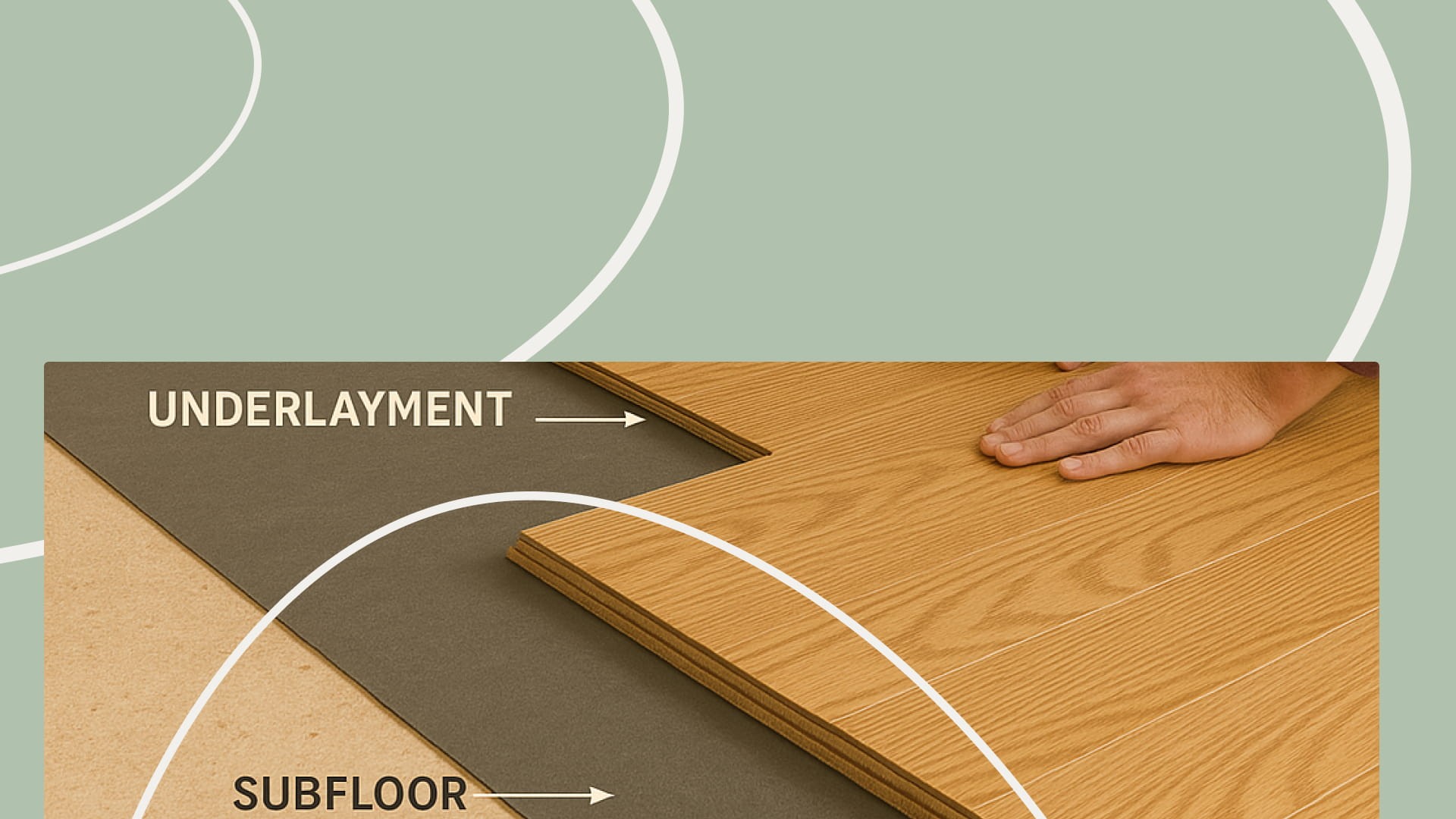Updated: April 1, 2025
Installing a hardwood floor is a big upgrade — one that deserves a solid foundation. That’s where underlayment comes in. If you're wondering what underlayment you need for hardwood floors, or even if you need one at all, this guide will clear it up. Whether you're working with solid hardwood or engineered hardwood, here's what you need to know to get it right the first time.
What Is Underlayment — and Why It Matters
Underlayment is a thin layer between your subfloor and hardwood flooring. It might look like an optional extra, but it plays a vital role in:
- Moisture protection (especially over concrete)
- Noise reduction (footsteps, echoes, creaks)
- Comfort underfoot
- Floor leveling over minor imperfections
- Thermal insulation
Skipping underlayment can lead to squeaks, cold floors, or even damage from trapped moisture. With professional hardwood flooring installation, this step will almost never be skipped.
Do All Hardwood Floors Need Underlayment?
Not always — but often. Here's the breakdown:
- Solid Hardwood (Nail-Down) Installations: Typically a 15 lb felt paper or rosin paper is recommended under nail-down hardwood. This acts as a slight cushion and moisture retarder, reducing wood-on-wood squeaks and protecting against subfloor moisture. Industry guidelines (e.g. NWFA Installation Guidelines) advise using such underlayment for nail-down installations.
- Engineered Hardwood Floors: Different installation methods:
- If floating (common for click-lock engineered planks), underlayment is usually required. Floating floors aren’t attached to the subfloor, so a padding layer is needed for support, noise reduction, and to allow the floor to expand/contract smoothly.
- If glue-down engineered, a separate underlayment is usually not used (the adhesive often doubles as a moisture barrier). However, for sound isolation in condos, sometimes an acoustical underlayment (like cork or rubber) is glued down then the wood is glued on top.
- If staple/nail-down engineered (some thinner engineered can be stapled to wood subfloors), treat it like solid hardwood – use felt or rosin paper underneath for moisture and squeak control.
- When Underlayment Might Not Be Needed: If a hardwood/engineered flooring product comes with a pre-attached underlay pad (more common with some engineered or laminate floors), you generally don’t add another pad. Just ensure there’s a moisture barrier if installing over concrete.
Underlayment is highly recommended in most cases for the reasons above – some flooring warranties even require it – but the type of underlayment will depend on your floor and installation.
Types of Underlayment for Hardwood Floors
Felt Paper (Flooring Felt)
A traditional underlayment for solid hardwood. Typically 15-pound asphalt-saturated paper (similar to roofing felt but specifically made for floors without the strong tar smell).
Pros:
- ✔️ Good basic moisture barrier for wood subfloors, helps minimize squeaks by isolating wood layers, inexpensive.
Cons:
- ❌ Minimal sound insulation or cushioning compared to foam.
Use for: Nail-down solid hardwood over plywood subfloor (industry standard), and also acceptable for nail-down engineered. Not used for floating floors (not thick enough to cushion a floating click-lock floor).
Rosin Paper
A thin red paper sometimes used in place of felt.
Pros:
- ✔️ Very cheap, easy to install, can help boards slide during installation and reduce dust.
Cons:
- ❌ Provides almost no moisture protection (rosin paper is not a vapor barrier) and minimal sound benefit.
Use for: Solid hardwood on above-grade plywood when cost is a concern and moisture is absolutely minimal – otherwise, 15 lb felt is generally preferred. (Rosin can be used in a pinch for squeak reduction, but it’s the least protective option.)
Foam Underlayment:
Foam sheets or rolls (often polyethylene foam) are common for floating installations.
Pros:
- ✔️ Lightweight, easy DIY installation, and provides excellent cushioning and some sound reduction. Many foam underlays come with a built-in plastic moisture barrier layer – critical for concrete subfloors. It’s the standard for floating engineered hardwood or laminate floors, as it cushions the floor and quiets impact noise.
Cons:
- ❌ Foam can compress over time under heavy furniture, losing some effectiveness. It’s generally not used under nail-down installations (too spongy under a nailed floor can cause instability – NWFA advises against foam padding under staples/nails).
Use for: Engineered hardwood (floating) over any subfloor; also floating plywood subfloors in some situations. Not recommended directly under nail-down solid wood.
Cork Underlayment:
Sheets or rolls of cork, usually ~1/4 inch thick.
Pros:
- ✔️ Eco-friendly (natural & renewable), excellent sound absorption and vibration dampening – great for reducing footstep noise, especially between floors. It also provides decent cushion and has some insulating properties to keep floors warmer. Cork doesn’t off-gas chemicals and even has anti-microbial characteristics (resists mold).
Cons:
- ❌ By itself, cork is not a moisture barrier – it will absorb water – so you must add a plastic sheeting or get cork with an attached vapor barrier when on concrete. It’s also a bit pricier than foam.
Use for: Engineered floating floors where sound control is a priority (e.g. upstairs rooms, condos), especially over wood subfloors where moisture is less a concern. It can also be used under a glue-down installation for sound insulation (glue the cork to subfloor, then glue wood on cork). Not typical for nail-down installs.
Rubber Underlayment
Rubber or rubber-fiber composite underlays (often from recycled tires, etc.).
Pros:
- ✔️ Dense and heavy – superb for sound reduction (many condo associations love rubber for its high impact noise absorption). It also provides a good thermal barrier and resists moisture (rubber itself is naturally moisture-proof). It has some cushion but is firmer than foam, which can make it suitable where you don’t want too much compression.
Cons:
- ❌ Cost – rubber underlay is usually the most expensive option. It’s also heavy to work with. Pure rubber can have an odor initially.
Use for: Situations demanding maximum sound insulation, like high-rise apartments or recording studios with hardwood floors. Can be used under floating or loose-lay floors; some rubber underlayments are also rated for nail-down installations (they’re firm enough not to compress heavily under nails). Always check manufacturer guidance.
Combination Underlays:
Tthere are premium underlayments that combine materials (e.g. felt/rubber blends) or include extra layers for specific purposes (a foam or fiber layer with an aluminum film for heat reflection, etc.). The DIY homeowner should choose a product that matches their needs (e.g. a foam with built-in vapor barrier is great for a slab foundation, or a felt-rubber blend pad for sound and moisture). The key is that any underlayment chosen for hardwood/engineered must be firm enough to support the wood – do not use carpet padding as a substitute, as it’s too soft and will cause the floor to flex or the joints to break.
Choosing the Right Underlayment: Factors to Consider
1. Subfloor Type & Condition
- #SubfloorPrep
- #MoistureBarrier
- #UnderlaymentChoice
Wood Subfloor (plywood or OSB): Use felt or rosin paper for nail-down installations, or semi-permeable underlayments like foam or cork for floating floors.
Concrete Slab: A moisture barrier is essential, using foam, rubber, or cork with integrated plastic vapor layers or additional poly sheeting.
Uneven Subfloor: Slightly thicker underlayments like cork or high-density fiber pads help smooth minor imperfections. Major issues require subfloor repairs.
2. Installation Method of Hardwood
- #NailDown
- #FloatingFloor
- #GlueDown
Nail-down: Use paper or felt to avoid interference with nails; avoid thick foam.
Floating Floors: Use foam, cork, or rubber underlayments designed specifically for floating installations.
Glue-down Floors: Usually no padding, unless a specialized glued-down underlayment is necessary for sound insulation.
3. Moisture Concerns
- #HumidityControl
- #KitchenBasement
- #VaporBarrier
Rooms prone to moisture like kitchens or basements need vapor-resistant underlayments like felt, rubber, or cork paired with vapor barriers. You should ask yourself where you should install hardwood floors and where you should not.
4. Sound & Noise Level
- #SoundInsulation
- #CondoRequirements
- #NoiseReduction
For sound reduction, rubber and cork underlayments offer superior noise insulation, essential for multi-story buildings or condos with specific STC/IIC ratings.
5. Comfort & Insulation
- #UnderfootComfort
- #ThermalInsulation
- #EcoFriendly
Comfort: Foam or thicker cork for cushioning; felt for balanced firmness.
Thermal Insulation: Cork or felt for warmth, ideal above unheated spaces or concrete slabs.
Environmental: Cork, felt, or recycled rubber underlayments are eco-friendly, low-VOC, and mold-resistant options.
6. Manufacturer’s Requirements
- #WarrantyCompliance
- #ApprovedMaterials
- #InstallationGuidelines
Always follow flooring manufacturer's guidelines to maintain warranties. Ensure your chosen underlayment meets or exceeds their specified requirements.
Tips for Installation of Underlayment (DIY Basics)
- Acclimate if required: Some underlayments (like cork rolls) might need to acclimate in the room just like hardwood does. Check instructions.
- Prepare the subfloor: Ensure the subfloor is clean, dry, and flat. Sweep thoroughly; any debris under the underlayment can cause issues.
- Lapping and Sealing: Lay out the underlayment according to type: roll out felt or paper in overlapping strips (overlap edges by about 4–6 inches for felt/rosin and staple them down). For foam or combo underlays, many have an adhesive strip to seal seams; otherwise use clear tape or duct tape to secure seams without gaps. This prevents the underlayment from shifting and ensures full coverage.
- Around edges: Run the underlayment up the wall a bit (for foam with vapor barrier, you often tuck a little up the wall so the edge of the floor is fully protected – you’ll trim the excess later). For felt, just make sure the entire floor area is covered.
- No doubling: Use one layer of the appropriate underlayment – don’t stack materials (e.g., don’t put foam on top of felt) unless a specific system calls for it. More padding is not always better and can cause instability.
- Cut outs: Cut the underlayment neatly around floor vents or obstacles. Tape any slit or cut you had to make, so there are no open gaps.



